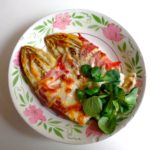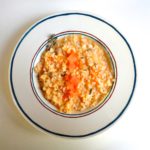 Some days you just need comfort food — so why not make an apple strudel? This delightfully flaky dessert has been popular in France since it was introduced at Versailles by Marie-Antoinette, who came here from her native Austria after marrying the future Louis XVI. It is exceptionally easy to make these days thanks to the availability of filo dough, which eliminates the painstaking step of stretching out kneaded dough until it is paper thin.
Some days you just need comfort food — so why not make an apple strudel? This delightfully flaky dessert has been popular in France since it was introduced at Versailles by Marie-Antoinette, who came here from her native Austria after marrying the future Louis XVI. It is exceptionally easy to make these days thanks to the availability of filo dough, which eliminates the painstaking step of stretching out kneaded dough until it is paper thin.
Strudel aux pommes / Apple strudel
Marie-Antoinette would have enjoyed other types of strudel when growing up in Vienna. Strudels filled with soft cheese, sour cherries and poppy seeds were all popular at the time. The pastry, defined by its rolled-up shape (strudel translates as ‘whirlpool’), can also be filled with meat or vegetables. It is said to derive from Turkey’s baklava, which entered Austria during the Ottoman occupation. It has many cousins, among them savory cheese pies like Greece’s tiropita, itself a variety of southeast Europe’s borek (watch this space).
You may be wondering whether strudel was what Marie-Antoinette had in mind when, upon being told that the peasants had no bread, she said ‘Let them eat cake’ — words reputed to have helped spark the French Revolution. Although whether she actually said this is far from sure, what is certain is that the phrase has nothing to do with strudel. In French it’s ‘qu’ils mangent de la brioche‘ (rough translation: ‘let them eat egg bread’).
Things didn’t end well, of course, for Marie-Antoinette, who lived a life of opulence and splendor only to be arrested, imprisoned and finally guillotined in public at the Place de la Révolution, today’s Place de la Concorde. Such are the risks of power when it is abused — glitz and wealth offer no protection. As we endure this bleak January, with or without strudel, we can take comfort in imagining that this may still hold true today.
Happy cooking.

 This recipe adds a couple of twists to a French classic, endives au jambon, which is enjoyed across the north of the country in the winter months. Twist Number 1: Dry-cured ham is used instead of the traditional baked ham. This adds sophistication and flavor. Twist Number 2: Cream is used instead of Béchamel sauce, making for a lighter dish. Travesty! Yes, for purists, but just try it.
This recipe adds a couple of twists to a French classic, endives au jambon, which is enjoyed across the north of the country in the winter months. Twist Number 1: Dry-cured ham is used instead of the traditional baked ham. This adds sophistication and flavor. Twist Number 2: Cream is used instead of Béchamel sauce, making for a lighter dish. Travesty! Yes, for purists, but just try it. There is an art to making potato pancakes, known in French as galettes de pomme de terre, or potato flat cakes. The basic recipe is very simple — grate the potatoes, mix with a beaten egg, season with salt and pepper, and fry in oil or duck fat. A humble dish served in many forms around the world, potato pancakes are supremely satisfying when they come out crisp and light. But achieving this is more difficult than one might think.
There is an art to making potato pancakes, known in French as galettes de pomme de terre, or potato flat cakes. The basic recipe is very simple — grate the potatoes, mix with a beaten egg, season with salt and pepper, and fry in oil or duck fat. A humble dish served in many forms around the world, potato pancakes are supremely satisfying when they come out crisp and light. But achieving this is more difficult than one might think. Roast duck is a festive dish in any season, but perhaps never better than in winter, enjoyed with a glass of hearty red beside a crackling fire. In this recipe, the duck is coated with a glaze of honey, thyme and balsamic vinegar, with garlic added to the roasting pan for a dish imbued with the flavors of southern France. Want to stay with the provençal theme? Serve the duck with pan-seared baby artichokes, this week’s second recipe.
Roast duck is a festive dish in any season, but perhaps never better than in winter, enjoyed with a glass of hearty red beside a crackling fire. In this recipe, the duck is coated with a glaze of honey, thyme and balsamic vinegar, with garlic added to the roasting pan for a dish imbued with the flavors of southern France. Want to stay with the provençal theme? Serve the duck with pan-seared baby artichokes, this week’s second recipe. Duck is served in many guises in France, although it is rather rarely seen roasted whole. The most common versions are
Duck is served in many guises in France, although it is rather rarely seen roasted whole. The most common versions are  We’re galloping toward the holiday season, so this post kicks off a series of recipes that you may enjoy pre-, post- and during the end of year festivities — beginning with two tartes fines, the French version of pizza. The first marries bacon and fresh sage, while the second sets baby spinach and mushrooms on a layer of cream. These are of course not holiday dishes, but they’re perfect for serving between the feasts — quick, simple, crowd-pleasing.
We’re galloping toward the holiday season, so this post kicks off a series of recipes that you may enjoy pre-, post- and during the end of year festivities — beginning with two tartes fines, the French version of pizza. The first marries bacon and fresh sage, while the second sets baby spinach and mushrooms on a layer of cream. These are of course not holiday dishes, but they’re perfect for serving between the feasts — quick, simple, crowd-pleasing. Tarte fine bacon et sauge
Tarte fine bacon et sauge A couple weeks ago, on a bright October day, I made this dish for a friend who was coming to dinner. I’d had pumpkin risotto at lunch that week at Merci, a café with creative cuisine across the street from me, and found it so delightful I wanted to try my hand at it. Now, in this dreary season, it’s good to have dishes like this to turn to for solace. Pumpkin risotto is comfort food at its best, and escaping into the kitchen is, for me, a kind of zen.
A couple weeks ago, on a bright October day, I made this dish for a friend who was coming to dinner. I’d had pumpkin risotto at lunch that week at Merci, a café with creative cuisine across the street from me, and found it so delightful I wanted to try my hand at it. Now, in this dreary season, it’s good to have dishes like this to turn to for solace. Pumpkin risotto is comfort food at its best, and escaping into the kitchen is, for me, a kind of zen. This fantastic recipe comes to me from
This fantastic recipe comes to me from  Every French school child learns that, back in around 1600, ‘good King Henri IV’ wanted to put a chicken in every pot. How much truth there is in this legend is still being debated by historians. What is incontestable, though, is that the dish called poule au pot to this day carries royal connotations. And yet, it is so simple. A chicken (or a hen) is boiled with vegetables to make a two-dish supper: first the soup, then the chicken and veggies.
Every French school child learns that, back in around 1600, ‘good King Henri IV’ wanted to put a chicken in every pot. How much truth there is in this legend is still being debated by historians. What is incontestable, though, is that the dish called poule au pot to this day carries royal connotations. And yet, it is so simple. A chicken (or a hen) is boiled with vegetables to make a two-dish supper: first the soup, then the chicken and veggies. Soufflés are often regarded as too difficult to attempt at home. I found this to be true when, as a young woman inspired by Julia Child, I set out to make one. Julia’s recipe for cheese soufflé in Mastering the Art of French Cooking stretches across nine pages, with long paragraphs on subjects like how to beat egg whites by hand. Not to be intimidated, I tried — with dubious results. Only after moving to Paris did I discover there is an easier way.
Soufflés are often regarded as too difficult to attempt at home. I found this to be true when, as a young woman inspired by Julia Child, I set out to make one. Julia’s recipe for cheese soufflé in Mastering the Art of French Cooking stretches across nine pages, with long paragraphs on subjects like how to beat egg whites by hand. Not to be intimidated, I tried — with dubious results. Only after moving to Paris did I discover there is an easier way. We’ve been having a September heat wave. Maybe this explains why so many Paris bistros are featuring Italian dishes at the moment. Most popular seems to be the assiette italienne, typically melon, parma ham, tomatoes, mozzarella and basil. But pasta is omnipresent too. At the ultra-trendy café Merci the other day, the special was a salad of pasta in pesto. In tune with this spirit, I decided to post one of my favorite pasta recipes.
We’ve been having a September heat wave. Maybe this explains why so many Paris bistros are featuring Italian dishes at the moment. Most popular seems to be the assiette italienne, typically melon, parma ham, tomatoes, mozzarella and basil. But pasta is omnipresent too. At the ultra-trendy café Merci the other day, the special was a salad of pasta in pesto. In tune with this spirit, I decided to post one of my favorite pasta recipes.

